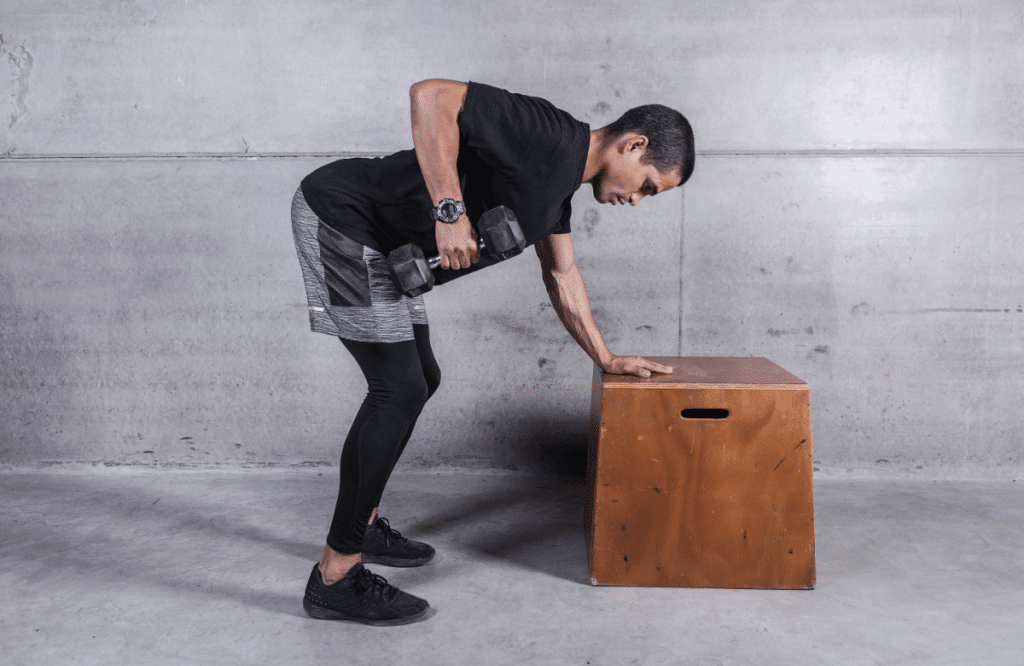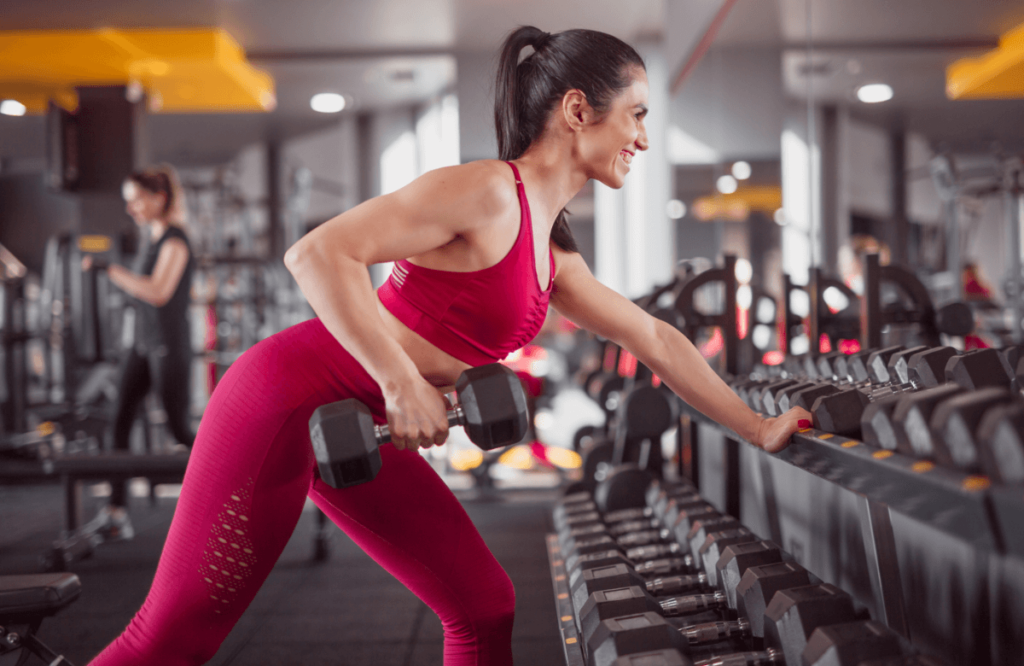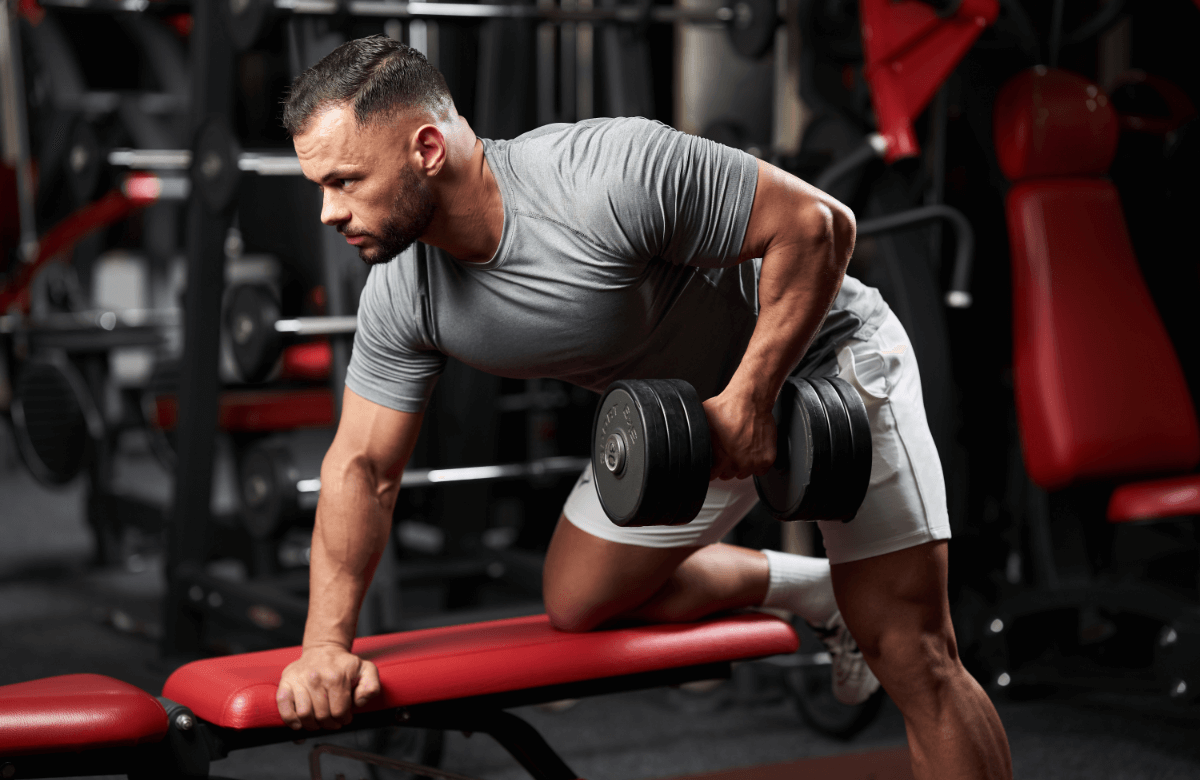Looking for a game-changing back exercise? The dumbbell row is one of the most underrated exercises when it comes to building a big thick back. Most people don’t do this exercise either because it creates tension in their lower back or they have a bad mind-muscle connection. We’re going to fix all that.
In this article, we’re going to be looking at the proper technique for the dumbbell row. Also, we are going to provide you with benefits, variations, and alternatives of dumbbell rows. Let’s get started.
Jump to:
What Is a Dumbbell Row?
Even though many people think of the dumbbell row as a back thickness exercise, it is in fact going to develop both back width and back thickness. This is an idea supported by research showing very high levels of lat and trap muscle engagement on rows. Dumbbell rows are so versatile and allow you to hit your back in so many different ways.
What Muscles Do Dumbbell Rows Work?
With dumbbell rows, we’re generally going to be performing some combination of:
- shoulder extension where you drive the elbows down and back;
- and scapular retraction where you squeeze your shoulder blades together at the top.
The shoulder extension component will be handled mainly by the lats. And the scapular attraction component will be handled mostly by the mid traps. This wonderful exercise also targets the posterior deltoid, rhomboid, bicep, tricep, and core muscles.

Benefits of Dumbbell Rows
There are plenty of people out there with impressive backs who use dumbbell rows in their programs and there are a few reasons why it’s usually an optimal choice if you’re trying to build up your mid-back and lats as effectively as possible.
1. It Provides Maximum Stimulation to Your Back Muscles
The main reason is just the fact that because of the position of the exercise where you’re standing bent over and holding on to a bench with leg support, you don’t have to make a lot of extra effort just to maintain the proper posture for the exercise as while performing barbell rows.
For a barbell row, your spinal erectors, glutes, and hamstrings have to kick into high gear just to keep your body in the right position which reduces the amount of focus that you can place on what really matters during the exercise, which is providing maximum stimulation to your lats and your mid-back muscles.
2. Reducing Lower Back Fatigue
A lot of time when people perform standard bent-over barbell rows especially beginners, they end up having to stop the set not because their lats and mid-back muscles truly begin failing but instead because of fatigue in the lower back and legs.
Many people will say that this is actually a good thing because it makes it more of a functional movement. However, if you’re already doing squats, deadlifts, and other posterior chain exercises, then that area is already being trained effectively. Therefore, there’s no reason to use a barbell row for that purpose, especially when the goal of the rowing exercise is to train your lats and your mid-back.
If you’re performing big compound movements like squats, deadlifts, and other similar exercises, then you’ll actually want to keep your lower back fresh for those exercises rather than overly fatiguing it on other lifts during the week.
Performing the dumbbell rowing movement you don’t have to put a bunch of energy into maintaining the proper posture. It will reduce lower back fatigue so that you’ll be stronger on your other compound lifts, squats, and deadlifts. It will reduce the chance of lower back injury as well.
3. It Prevents Muscle Imbalance
One other benefit of single-arm dumbbell rows is that each arm will be trained independently. This gives you more natural movements since both arms won’t be locked onto a fixed bar and it will prevent strength imbalances.
Who Should Do the Dumbbell Row?
CrossFitters, Olympic lifters, powerlifters, and everyone who wants to develop muscle hypertrophy and back strength benefit from incorporating dumbbell rows into their workout routines.

How to Do Traditional Dumbbell Rows
Let’s break this down into separate sections.
1. Protract at the Bottom
Begin each rep by allowing your scapula to protract at the bottom which is going to allow the traps to work through a full range of motion.
Allow the dumbbell to drift slightly forward which is going to achieve more stretch on the lats while creating more consistent tension preventing the dumbbell from stopping directly beneath the shoulder.
2. Drag Back
You want to think about dragging the dumbbell back in an arc instead of straight up. You should be pulling the dumbbell back toward your hips and then allowing it to come both down and forward under control on the negative.
3. Moderate Torso Rotation
A lot of people use a lot of torso rotation to cheat the dumbbell all the way up and then just let the weight fall on the negative. That’s something we also wouldn’t recommend.
There is a middle ground here where a moderate amount of torso rotation can be used to assist the lats at their weakest point in the lift. This is going to allow other muscles to contribute more equally and prevent premature fatigue simply due to the lat’s inability to complete a full range of motion.
4. Elbows Close to Your Torso
You should be keeping your elbows close to your torso rather than flaring them out to the side. If your biceps dominate, keep your elbow in a fixed position and pull more with your lats.
5. The Angles
For the angle of your back, the more parallel you are to the floor, the more activation of the spinal erector muscles and the lower part of your lats to stabilize the weight.
Don’t overlook those extreme upright angles. Most people get in this position and they’re missing out on a huge benefit. As you drive those elbows up, it creates a more intense contraction in those traps and you’ll feel even more in those mid and lower traps as well.
The angle of your elbow matters. The higher it goes, the more it’s going to drive into that upper back and rear shoulder muscle.
6. The Grip
Do dumbbell rows with a neutral grip. But we would recommend you try to slightly supinate that wrist because it’s going to force your body to contract up on a different path.
If you find your biceps or your grip giving out before your back, you can try placing your pinky toward the back end of the dumbbell or consider using straps to shift emphasis away from your grip and onto the muscles of the back that you’re actually trying to target.
7. Open Up Your Shoulders
If your shoulders dominate, then more than likely you’re just rowing the weight but not actually contracting your back. To do that, you have to really open up your shoulders.
Try to cut the range of motion in half and focus on that movement of contracting your back and pulling your shoulders back. Once you can get that, you can slowly work into a full range of motion.
8. Find What Works for You
Change the angle of your body, elbows, and hand position to find a row you really connect with. If you’re still not connecting, change the range of motion or try to keep the elbow in a fixed position to see how that feels.

How Much Weight to Use
The dumbbell row exercise can be used as both a heavy overloading compound movement and a mind-muscle connection type of movement. Both low reps and high reps can be used.
However, because you need to work each side separately, we recommend you stick with a more moderate rep zone something around 8 to 12 reps per side, to save on time and energy.
Load the dumbbell row with moderate weight. If you are a beginner, use 10 to 20-pound dumbbells (5 to 10kg). Intermediate and advanced users need to aim for around 30 to 35-pound dumbbells and above.
6 Dumbbell Row Variations
Here are our 6 dumbbell row variations. Use a variation that feels most comfortable for you.
1. One-Armed Dumbbell Rows
You’re going to set up an inclined bench at a 45-degree angle. Place your hand and knee on the bench with your other foot out further to the side to create a wide stable base of support. With the dumbbell row like all unilateral exercises, you should start with your non-dominant side to prevent muscle imbalances.
To maximize the range of motion on any row, your torso should be close to perpendicular to the line of pull. In other words, your back should be somewhere between 0 to 20 degrees above parallel to the floor. Staying too upright might allow for heavier loading but is going to seriously limit the range of motion that the lats can perform.
Hold on to a dumbbell using a neutral grip with your outer hand. Press your other hand into the bench to support your upper body and from there row the dumbbell up toward your waist until you feel a strong contraction in your lat and mid-back muscles.
Lower the dumbbell back down until your arm is extended toward the floor and then repeat.
2. One-Armed Bench Dumbbell Rows
Another option is to perform the single arm dumbbell row using a flat bench. Just put one hand and one knee up on the bench and your other leg out behind you.
You are going to have a slight bend in your knees to protect your lower back. Keep your back neutral and flat. If you start arching, you still train your lats but you lose a lot of the lower lat focus and a lot of tension goes up. You want to work your whole lat.
You want to take a dumbbell and bend over with good posture. Your chest is forward and your core is tight. You want to pull the dumbbell up. Squeeze the shoulders back and stick the chest out.
3. Dumbbell Seal Row
In this dumbbell rowing variation, your chest and lower back are supported and both dumbbells are being rowed at the same time. As you row the dumbbells toward yourself, focus on squeezing your shoulder blades together.
4. Dumbbell Renegade Row
Dumbbell renegade rows build serious core stability and strength and develop your back and quad strength.
Start in a high plank position. You are going to hold dumbbells with your hands underneath your shoulders. Pull the dumbbell up towards your shoulder. Don’t turn your hips. Bring the dumbbell back with control. Repeat with the other arm.
Common mistakes:
- hips swaying from side to side:
- not keeping your shoulders in a stable position;
- half reps.
5. Incline Bench Dumbbell Row
The next variation is the incline chest-supported dumbbell row. This one is good for people who have a little bit of fatigue in the lower back and legs.
You are going to lay on an inclined bench with your feet on the ground. If you use a pronated grip, this exercise will target a lot of upper back muscles such as rhomboids, traps, and rear deltoids. If you do this with a neutral grip, it turns into more lats exercise. By the way, try doing this exercise with kettlebells to get a little bit more range of motion.
6. Bent-Over Dumbbell Row
The dumbbell bent-over row is all about hip hinging. You need to learn this position where you’re not squatting down. A squat is bending at the knees and the hips. A hip hinge is predominantly a hip tilting position where your pelvis goes backward and you’re tilting from the hips. You also bend your knees a little bit.
You are going to come down to a position where your torso is almost parallel to the floor or just a little higher up. You might feel the hamstrings and glutes engaged. If they are engaged, they’re protecting your back.
The next major focus in this exercise is the position of your spine. The biggest mistake in any bent-over row is the rounded back position. In this case, you’re going to put a lot of stress on that lower back. You need to lengthen your spine and keep it straight.
The arms should hang naturally underneath the shoulders. You don’t want to be rowing directly straight up into your shoulders. You need to shorten your lats by pulling the shoulders back and driving the elbows to your back up as high as you can. Make sure you engage your core.
Mistakes to Avoid When Doing Dumbbell Rows
1. Too Much Momentum
The most common error is just losing control. While some momentum is acceptable, once you start getting your legs, calves, and the planted arm involved, it’s just going to turn into a completely different movement and it’s going to rob tension from the back itself.
Remember that the point of using momentum is to help even out the strength curve of the lats not to move more weight just to impress your friends.
2. Staying Too Upright
Another very common mistake is staying too upright on dumbbell rows. Many lifters will use the dumbbell rack itself or the back of an incline bench which we wouldn’t recommend because you’re only going to be taking the lats through a partial range of motion.
To maximize the range of motion on any row, your torso should be close to perpendicular to the line of pull. This means you shouldn’t lean too far back on a cable row and you shouldn’t be too upright on a dumbbell row.
3. Rowing Too Strictly
A third error is doing ultra-strict rows while being more strict can have its place such as on a chest-supported t-bar row. When it comes to dumbbell and cable rows, being overly cautious and rigid can seriously reduce overloading potential and even halt progression.
Even just a little bit of cheating can transform the dumbbell row into a much more effective exercise.
Dumbbell Row Alternatives
1. One Arm Barbell Row
Put a bar in a landmine or stick it in the corner of a gym. Use smaller plates. This will give you more range of motion so you can pull up a little higher.
Grab the barbell and lift it to your chest keeping your head in a neutral position. Try to keep your back straight and prevent it from rounding.
2. Bent-Over Barbell Row
Start with your feet shoulder-width apart, feet close to the bar. Use an underhand grip which means your palms facing up towards the ceiling. Grip the bar outside your feet.
Keep a neutral spine, your head up and your shoulders back. The angle of your back is important. Make sure the angle of your back is enough to target the center of your back.
You want to exhale as you bring it towards your hips and inhale on the way down. When you finish, lift it back down to the ground.
3. Meadows Row
Use a landmine attachment. When you do this row, you’re going to be standing sideways to a bar.
When you’re training your lats, a general rule is a neutral grip. For better activation of your rhomboids, lower traps, and rear deltoids, you need to use a pronated grip.
The meadows row is primarily for your rhomboid and lower trap thickness because of a pronated grip.
Lean on your knee with the arm that’s not working and give yourself a good, solid base. Keep your spine flat. Drive with your elbow. The only thing moving is your elbow. Your torso is completely immobile.
4. Pendlay Row
This type of row tends to be a more equal mix of lats and traps implying you may not stand to benefit quite as much from moderate cheating.
With a standing barbell row, where you have a more upright posture, moderate cheating can be helpful if you find your lats fatiguing early and preventing you from reaching that full scapular retraction at the top.
Be careful to limit your cheating since using momentum can create a slippery slope between true progressive overload and just progressive cheating.
5. Cable Row
When it comes to the cable row, whether or not we advise cheating depends on the grip being used. With a close neutral grip, because the lats will be more involved, we recommend you use a bit more momentum by leaning forward at the hips allowing the spinal erectors of the lower back to assist the lats through the end range.
With a wider grip, the row becomes more scapular-retraction based meaning more trap and rear delt involvement. In this case, we recommend you keep a more upright posture focusing on protracting your shoulder blades at the bottom and retracting them at the top.

Dumbbell Rows: FAQs
How important are dumbbell rows?
Dumbbell rows are the superior choice for muscle-building purposes. They work out all the muscles of the back and help correct your posture as well.
Are dumbbell bench rows good?
Dumbbell bench rows are an effective exercise for muscle growth and muscle development. They will train targeted muscles in a more balanced way. They’ll reduce lower back fatigue as well as the chances of lower back injury.
Are rows bad for the spine?
Classic dumbbell rows will strengthen your major back muscles if you use proper form. One-arm rows keep your lower back and legs supported and let you put all of your focus where it should be, which is on training your lats and mid-back as hard as you can.














